Boost Productivity in 2025: How Circadian Rhythms Research Shapes Your Day

The latest research on circadian rhythms significantly impacts productivity in 2025 by optimizing work schedules, enhancing sleep quality, and improving overall cognitive function, aligning our daily activities with our natural biological clocks.
In 2025, understanding and leveraging your body’s natural clock is no longer just a health trend; it’s a crucial element for maximizing productivity. How does the latest research on circadian rhythms impact productivity in 2025? The answer lies in the science of aligning daily activities with your internal biological clock, which can lead to improved focus, better sleep, and increased overall performance.
Decoding Circadian Rhythms: A 2025 Perspective
Circadian rhythms are more than just sleep-wake cycles; they are intricate 24-hour cycles that govern a multitude of bodily functions. Understanding these rhythms is paramount to unlocking peak productivity in 2025. This isn’t just about feeling less tired; it’s about optimizing your body’s natural schedule to perform at its best.
The Core of Circadian Rhythms
At its core, the circadian rhythm is regulated by a master clock located in the brain, specifically the suprachiasmatic nucleus (SCN). Sunlight, meal times, and physical activity all serve as external cues that synchronize our internal clock with the external environment. Disruptions, such as irregular sleep patterns or shift work, can throw this delicate balance off, leading to a host of health and productivity issues.
The Impact on Daily Life
The implications of circadian rhythms stretch far beyond sleep. Hormone production, body temperature, and even cognitive functions like alertness and memory are all synchronized with this internal clock. By tuning into our circadian rhythms, we can identify the optimal times for different activities, maximizing efficiency and minimizing wasted effort.
- Sleep Optimization: Understanding your chronotype (e.g., morning lark or night owl) allows for tailored sleep schedules, leading to deeper and more restorative sleep.
- Meal Timing: Aligning meal times with your circadian rhythm can improve digestion and nutrient absorption, contributing to sustained energy levels throughout the day.
- Exercise Timing: Identifying the best time of day for physical activity can enhance performance and recovery, maximizing the benefits of your workouts.

In conclusion, understanding the core principles of circadian rhythms is the first step toward optimizing productivity in 2025. This knowledge enables us to make informed decisions about our daily routines, leading to improved health, well-being, and performance.
Sleep Quality: The Bedrock of Productivity
Adequate and restful sleep is the foundation upon which all productivity gains are built. Latest research emphasizes that prioritizing sleep quality is not just about getting enough hours, but ensuring that sleep aligns with your natural circadian rhythm. Ignoring this can lead to decrease on productivity.
The Science of Sleep Cycles
Sleep is not a monolithic state, but rather a series of cycles, each lasting approximately 90 minutes. These cycles consist of stages of light sleep, deep sleep, and REM sleep, each with its unique restorative benefits. Deep sleep is crucial for physical recovery, while REM sleep is essential for cognitive processing and memory consolidation.
Strategies for Enhancing Sleep Quality
To improve sleep quality, several strategies can be implemented. These include optimizing the sleep environment (e.g., dark, quiet, and cool), establishing a consistent sleep schedule, and avoiding stimulants like caffeine and alcohol before bed. Additionally, practices like meditation and mindfulness can help reduce stress and promote relaxation, contributing to better sleep.
Furthermore, technology plays a role in helping to track and improve sleep quality. Wearable devices and sleep-tracking apps can provide valuable insights into sleep patterns, identify areas for improvement, and even offer personalized recommendations.
- Consistent Bedtime Routine: Establishing a regular bedtime routine helps signal to the brain that it’s time to sleep, promoting relaxation and easier sleep onset.
- Optimized Sleep Environment: Creating a dark, quiet, and cool sleep environment minimizes distractions and promotes deeper, more restful sleep.
- Mindfulness and Meditation: Practicing mindfulness and meditation can help reduce stress and promote relaxation, leading to improved sleep quality.
In conclusion, sleep isn’t a luxury; it’s a necessity. By prioritizing sleep quality and aligning sleep schedules with natural circadian rhythms, individuals can experience significant improvements in productivity, focus, and overall well-being in 2025.
Light Exposure: The Key to Circadian Alignment
Light is one of the most powerful regulators of the circadian rhythm. Understanding how light exposure affects your body’s internal clock is vital for maximizing productivity. Optimizing exposure can make a big difference in how you manage your day.
The Role of Natural Light
Natural light, particularly sunlight, is the primary synchronizer of the circadian rhythm. Exposure to sunlight in the morning helps to suppress melatonin production and increase alertness, setting the stage for a productive day. Conversely, darkness in the evening triggers melatonin release, promoting relaxation and preparing the body for sleep.
The Dangers of Blue Light
However, not all light is created equal. Blue light, emitted by electronic devices like smartphones and computers, can interfere with melatonin production and disrupt sleep. Reducing blue light exposure in the evening is essential for maintaining healthy sleep patterns and optimizing circadian alignment.

In the evolving landscape of 2025, strategic light exposure proves pivotal in aligning with circadian rhythms, thereby optimizing productivity. Integrating sunlight into your morning routine, coupled with limiting blue light in darker periods, will foster better sleep quality and elevated alertness.
- Morning Sunlight: Expose yourself to natural sunlight in the morning to suppress melatonin and boost alertness.
- Blue Light Filters: Use blue light filters on electronic devices in the evening to minimize sleep disruption.
- Light Therapy: Consider using a light therapy lamp during the winter months or for individuals who have limited access to natural light.
Understanding and optimizing light exposure is a crucial component of circadian rhythm entrainment. By strategically using light, individuals can improve sleep quality, boost alertness, and enhance overall productivity in 2025.
Nutrition’s Impact: Fueling Your Internal Clock
What you eat and when you eat it plays a significant role in regulating your circadian rhythm and influencing your productivity levels. Making conscious dietary choices can help synchronize your internal clock and optimize your energy levels throughout the day. This directly affects your cognitive function and productivity.
The Science of Chrononutrition
Chrononutrition is the study of how the timing of meals affects circadian rhythms and overall health. Research has shown that eating at regular times each day can help reinforce the body’s natural clock, while irregular eating patterns can disrupt it.
Dietary Strategies for Circadian Alignment
To support circadian alignment through nutrition, several dietary strategies can be implemented. These include eating a balanced breakfast to kickstart the metabolism, avoiding heavy meals close to bedtime, and consuming foods rich in tryptophan, an amino acid that promotes relaxation and sleep.
Practical Tips for Dietary Optimization
Consider incorporating specific foods and eating habits into your routine to maximize the benefits. For example, include protein and complex carbohydrates in your breakfast to provide sustained energy throughout the morning. Limit caffeine consumption in the afternoon to avoid sleep disruption. Choose lighter, easily digestible meals for dinner to promote restful sleep.
This proactive approach towards nutrition is essential for cultivating a resilient and efficient internal clock, significantly impacting productivity and overall well-being in 2025.
- Regular Meal Times: Stick to consistent meal times each day to reinforce the body’s natural clock.
- Balanced Breakfast: Eat a balanced breakfast to kickstart the metabolism and provide sustained energy.
- Avoid Late-Night Meals: Avoid eating heavy meals close to bedtime to promote restful sleep.
In conclusion, nutrition is a powerful tool for regulating the circadian rhythm and optimizing productivity. By making conscious dietary choices and aligning meal times with the body’s natural clock, individuals can improve energy levels, sleep quality, and overall well-being in 2025.
The Role of Exercise: Timing Your Workouts for Maximum Benefit
Regular physical activity is beneficial for overall health, but the timing of your workouts can also impact your circadian rhythm and productivity levels. Understanding how exercise interacts with your internal clock is crucial for maximizing its benefits.
The Science of Exercise and Circadian Rhythms
Exercise can act as a potent zeitgeber, or time cue, for the circadian rhythm. Studies have shown that exercising in the morning can help advance the circadian clock, making you more alert and productive during the day. Exercising too close to bedtime, on the other hand, can disrupt sleep.
Best Practices for Exercise Timing
To optimize the effects of exercise on your circadian rhythm, consider these best practices. Aim to exercise in the morning or early afternoon to boost alertness and improve sleep quality. Avoid intense workouts close to bedtime, as they can interfere with relaxation and sleep onset.
Combining Exercise with Light Exposure
Combine outdoor exercise with morning sunlight exposure for a double dose of circadian synchronization. This combination can help suppress melatonin production and increase alertness, setting the stage for a productive day. Take advantage of natural daylight by choosing outdoor activities like walking, running, or cycling.
- Morning Workouts: Exercise in the morning to advance the circadian clock and boost alertness.
- Avoid Late-Night Workouts: Avoid intense workouts close to bedtime to promote restful sleep.
- Outdoor Exercise: Combine outdoor exercise with morning sunlight exposure for a double dose of circadian synchronization.
In conclusion, exercise timing is a crucial factor in regulating the circadian rhythm and optimizing productivity. By aligning workouts with your body’s natural clock and combining them with light exposure, individuals can improve sleep quality, boost alertness, and enhance overall well-being in 2025.
Technology’s Influence: Managing Digital Habits for Better Sleep
In the digital age, technology plays a pervasive role in our lives. The ways that we utilize electronic devices and apps significantly impacts our circadian rhythms and influences our productivity levels. Effectively managing digital habits results in an improvement in sleep and daily productivity.
The Impact of Digital Devices on Sleep
The blue light emitted by electronic devices can suppress melatonin production and disrupt sleep. Excessive screen time, especially in the evening, can lead to difficulty falling asleep, reduced sleep quality, and daytime fatigue.
Strategies for Managing Digital Habits
To mitigate the negative effects of technology on sleep, several strategies can be employed. These include reducing screen time in the evening, using blue light filters on electronic devices, and creating a digital curfew to disconnect from technology before bed.
Leveraging Technology for Circadian Alignment
Harness the power of technology to monitor and refine your sleep patterns. Innovative tools like wearable devices and specialized apps can provide valuable insights into your sleep quality, identify areas for improvement, and even suggest personalized strategies to optimize your circadian rhythm.
- Reduce Screen Time: Reduce screen time in the evening to minimize blue light exposure.
- Use Blue Light Filters: Use blue light filters on electronic devices to minimize sleep disruption.
- Digital Curfew: Create a digital curfew to disconnect from technology before bed.
In conclusion, technology can be a double-edged sword when it comes to circadian rhythms. By managing digital habits effectively and leveraging technology for circadian alignment, individuals can improve sleep quality, boost alertness, and enhance overall productivity in 2025.
Creating a Personalized Circadian Rhythm Plan for 2025
Understanding your body’s unique circadian rhythm is the key to unlocking peak productivity. A one-size-fits-all approach won’t work; creating a personalized plan based on your individual chronotype, lifestyle, and preferences is essential. Tailoring daily activities to align with your internal body clock will promote a day of increased productivity.
Assessing Your Chronotype
Are you a morning lark or a night owl? Understanding your natural sleep preferences can help you optimize your schedule. Morning larks tend to be most productive in the morning, while night owls often peak in the evening. Tailor the type of work you do in accordance to your circadian.
Customizing Your Daily Routine
Consider the optimal times for different activities based on your chronotype and lifestyle. Schedule demanding tasks for when you’re most alert and focused, and save less critical tasks for times when your energy is lower. Align your meal times, exercise schedule, and sleep patterns with your body’s natural rhythm.
Take the opportunity to fine-tune every aspect of your day to align with your inner rhythms, promoting enhanced focus and increased personal satisfaction.
- Chronotype Assessment: Evaluate your natural sleep patterns to identify your chronotype.
- Optimized Scheduling: Maximize productivity by scheduling demanding tasks for peak alertness times, and conserve times of low energy.
- Flexible Adjustments: Build adjustments into the customized program for optimal time of day.
You can achieve previously unmanageable productivity levels by personalizing your circadian rhythm with science supported facts. When we are in alignment with mother time, it yields the most efficient and successful benefits for our lifestyle.
| Key Aspect | Brief Description |
|---|---|
| ☀️ Light Exposure | Optimize morning sunlight & reduce evening blue light for better sleep/alertness. |
| 🍽️ Nutrition | Eat regular meals, balanced breakfasts, & avoid late-night meals. |
| 🏋️ Exercise Timing | Morning workouts boost alertness; avoid intense exercise before bed. |
| 📱 Digital Habits | Limit screen time, use blue light filters, & establish a digital curfew. |
Frequently Asked Questions
▼
Circadian rhythms regulate alertness, focus, and energy levels throughout the day. Aligning your work schedule with your natural rhythm can enhance productivity and reduce fatigue, ensuring peak performance.
▼
Exercising in the morning is generally recommended as it helps advance the circadian clock and boost alertness during the day. However, if morning workouts aren’t feasible, aim to exercise at least a few hours before bedtime.
▼
Use blue light filters on electronic devices, reduce screen time in the evening, and create a digital curfew at least an hour before bed to minimize blue light exposure and promote better sleep.
▼
Eat regular, balanced meals with plenty of fruits, vegetables, and lean protein. Include a balanced breakfast to kickstart your metabolism and avoid heavy meals close to bedtime for sound nights rest.
▼
Chrononutrition is the study of how meal timing affects circadian rhythms. Eating at regular times each day can reinforce your internal clock, improving energy levels, sleep quality, and overall well-being.
Conclusion
In 2025, leveraging insights from circadian rhythm research is vital for maximizing productivity and overall well-being. By strategically aligning daily activities with your body’s natural clock, prioritizing sleep quality, managing light exposure, optimizing nutrition, and being mindful of technology’s influence, you can create a personalized plan that empowers you to thrive in every aspect of your life.





